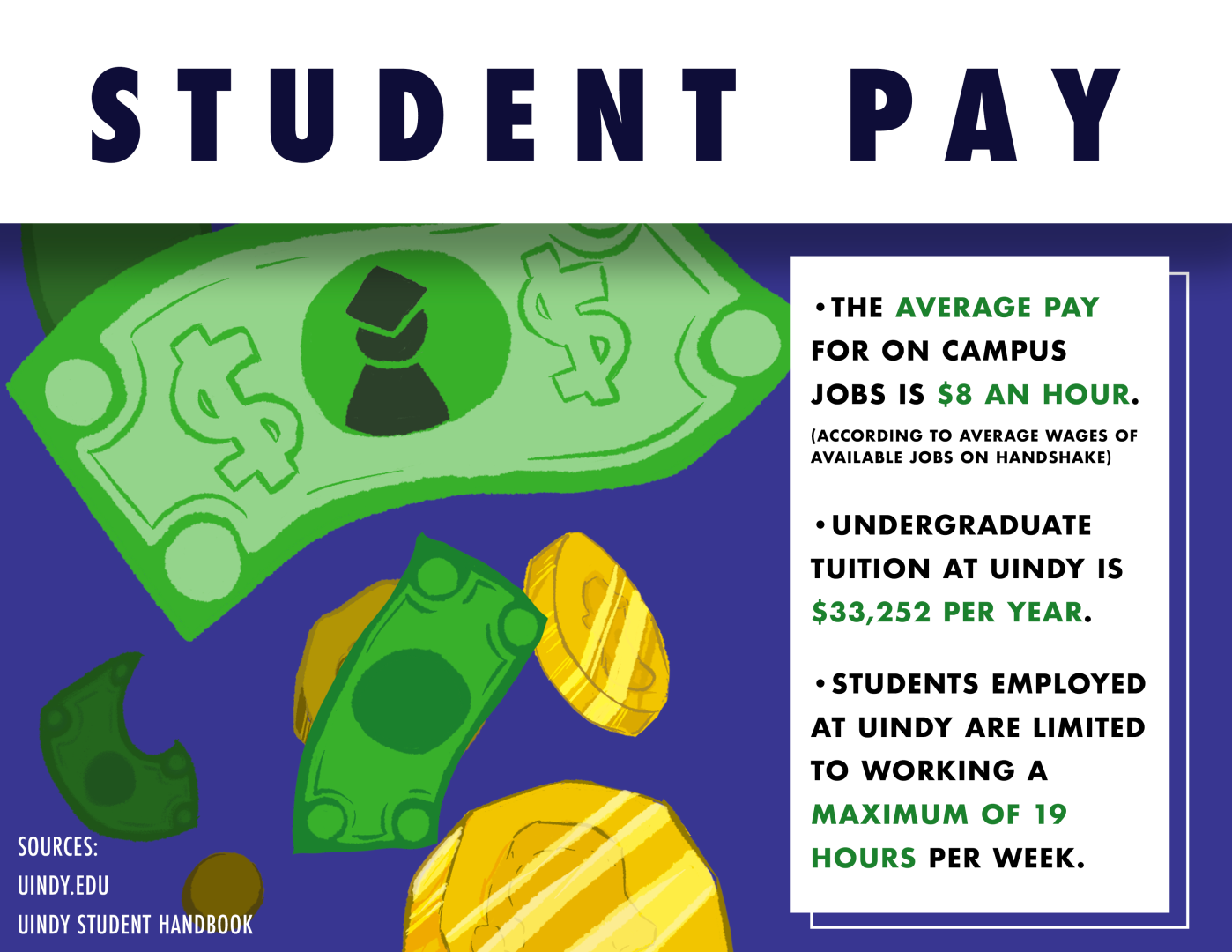I love working at the University of Indianapolis–minus one thing. I adore my job. I love my supervisors. I love my coworkers. I love the satisfaction of being able to help my fellow Greyhounds and their families. The one thing that isn’t the best? The pay. I am paid a little over nine dollars an hour, even when some days there’s not a moment to rest.
Well, isn’t nine dollars over the $7.25 federal minimum wage? Yes—but I am more fortunate than other students who work at UIndy.
The base tuition cost for a full-time, undergraduate student at UIndy is $33,252 per year, according to the university’s website. That means that regardless if a traditional undergrad student lives on campus, off-campus or is a commuter, their tuition is over $33,000—plus the $860 in non-negotiable fees per semester, or an additional $1,720 per year. Now, the price increases if a student chooses to live on campus. A basic room (two residents) in Warren Hall costs $3,066 per semester, or $6,132 per year, according to UIndy’s website. Anything above the basic dorm halls will cost more.
Don’t get me wrong, I love UIndy dearly. The community, the professors, the staff and my peers are amazing. Additionally, I am one of five people in my family who has graduated/is currently attending UIndy. But students pay a lot of money to go here, and being paid the government-bare-minimum by the institution that they pay thousands to is, honestly, a bit demeaning.
According to the UIndy Student Employee Handbook, “For each academic year, student employment positions are paid, at minimum, the federal minimum wage. Wages per hour (above minimum wage) are decided upon by the hiring and budget manager for the office or department hiring a student employee.” The handbook also limits students from working more than 19 hours a week during the school year—students who are not able to travel for a job but need money who work at the university may find themselves struggling to make ends meet.
Why can’t we standardize a higher university minimum wage when the cost of attending and cost of living has increased (see The Reflector “Student life affected by inflation”)?
The different, respective offices and departments of UIndy use the job application site, “Handshake,” to post open student positions.
Here are some examples of available, on-campus jobs and hourly pay rates on “Handshake” as of Sept. 28, 2022 at nine in the morning:
- 2022-23 Resident Assistant (RA), $7.25
- Tennis Center-Front Desk, $7.25
- Engineering Learning Assistant, $8.00
- University Events Event Staff, $8.50
- Chemistry Tutor, $9.00
- Student Assistant, Departments of Mathematical Sciences & Physics and Earth Space Science, $9.00
- Grounds Student Assistant, $10.00
The list does not include all of the jobs available—just a selection to reflect the range of pay. Overall, I calculated the average pay by hour for the 18 available positions to be around $8.80. According to data from the U.S. Bureau of Labor Statistics, the national average hourly wage for education and health services was $32.04 in Aug. 2022. Now, I’m not saying that we need to be paid over $30 an hour for a student-level job; however, I am saying that one-half ($15) or even three-eighths ($12) of the national average would be appropriate (and considerate).
Data from National Center for Education Statistics (NCES) shows that the number of full-time and part-time, undergraduate, college student workers has been decreasing. In 2000, 53% of undergrad students had some type of employment, on or off campus. Statistics from 2018 show that there was a 10% decrease from the number of employed, undergrad students in 2000. The trend for part-time, undergraduate student employment follows a similar, yet more mild, trend with 85% employed in 2000 and 81% in 2018.
So, what could help reverse the trend of decreased college student employment? (Again, recall that UIndy has 18 active job postings, some with urgency.) Pay student-workers more—that will show that the university values them, not only as paying attendees, but as people, too.









